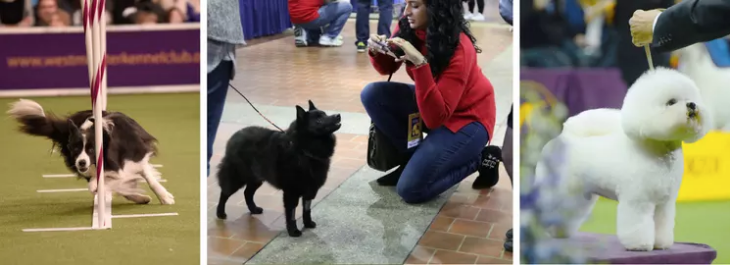What is Westminster?
The Westminster Kennel Club is America’s oldest organization dedicated to the sport of purebred dogs. Established in 1877, Westminster’s influence has been felt for more than a century through its famous all-breed, benched dog show held every year at New York City’s Madison Square Garden. Today, America’s dog show has expanded into Westminster Week which includes the Masters Agility Championship at Westminster and the Masters Obedience Championship at Westminster. More than 3,000 dogs entered from around the world make Westminster Week like no other. As Master Groomer and our founder, Melissa Verplank encourages our pet grooming students to watch Westminster as a great way to improve their pet trims! (watch Melissa’s video HERE )We’ve highlighted information to help you tune in.
Learn more @ Westminster
How a Dog Show Works
Each dog at a dog show is presented to a judge by either its owner, breeder, or a hired professional. This person is known as the exhibitor or the handler of the dog.
The purpose of conformation shows (also known as dog shows) is to evaluate breeding stock. Judges select winners based on their ability to contribute and improve the next generation of dogs. Dogs start out in the classes competing for points toward their AKC championship title. Dogs win points based on the number of dogs defeated. The more dogs entered, the more points per win. It takes fifteen points, including two majors (wins of three, four or five points), awarded by at least three different judges, to become an American Kennel Club champion.
Breed Groups judged to the AKC Breed Standard include the Working, Herding, Sporting, Hound, Terrier, Toy, Non-Sporting and Herding.
Learn more, including judging criteria, a glossary and terminology, at Westminster Dog Shows 101
Watch Dog Show 101:
Westminster Week Schedule: 147th WKC Dog Show
SATURDAY, May 6, 2023
- Masters Agility Championship
- Preliminaries 8:00am – 4:00pm
- Finals Competition 7:00pm – 9:30pm
Agility is a timed competition that tests a dog’s ability to complete an obstacle course following the commands of its handler. Purebred and All-American (mixed breed) dogs are eligible, to compete in 1 of 5 height classes and are judged on time and completion (minus faults) of the course.
- Masters Obedience Championship
- 9:00am – 3:00pm
Obedience is a command-driven competition that tests a dog’s ability to comply with the asks of the handler. Commands can include a combination of sit, stay, jump, retrieve and scent discrimination. Purebred and All-American (mixed breed) dogs will compete to showcase the desired skills of a model dog.
Today, Westminster will also host Obedience, Dock Diving, a Breed Showcase & More
Learn more here: Westminster Schedule
MONDAY, MAY 8, 2023
- Breed Judging
- Judging of Hound, Toy, Non-Sporting and Herding breeds and Junior Showmanship Preliminaries
- 8:00am – 4:30pm
The dogs entered at the Westminster Kennel Club Dog Show each competes within their own breed to be chosen as Best of their Breed/Variety. There are 212 AKC-recognized breeds and varieties.
Junior Showmanship is a competition assessing the handling skills of children 9-18 years of age independent of the traits of the dog. The competition promotes proper training and care to prepare future generations for responsible dog ownership, sportsmanship, and future success in the sport.
- Group Judging
- Judging of the Hound, Toy, Non-Sporting, and Herding Groups
- 7:30pm – 11:00pm
Once selected as Best of Breed/Variety, dogs advance to compete within their AKC-recognized Group: Hound, Toy, Non-Sporting, Herding, Sporting, Working, and Terrier.
TUESDAY, MAY 9, 2023
-
- Breed Judging
- Judging of Sporting, Working and Terrier breeds and Junior Showmanship Preliminaries
- 8:00am – 4:30pm
- Junior Showmanship Finals
- 7:00pm-7:30pm
- Group Judging
- Judging of Sporting, Working, and Terrier Groups
- 7:30pm – 11:00pm
- Best in Show
The winning dogs across the seven Groups compete for the ultimate prize. From those seven Reserve Best in Show is awarded as a runner up, followed by the Best in Show selection.
Times are subject to change. All times EDT.
- Breed Judging
On Air Programming & Live Streaming Info for 2023:
https://www.westminsterkennelclub.org/2023-dog-show-info/fox-fs1-and-fs2



 Excellent grooming starts always starts with a firm understating of canine anatomy. It is the FOUNDATION of all grooming.
Excellent grooming starts always starts with a firm understating of canine anatomy. It is the FOUNDATION of all grooming.


